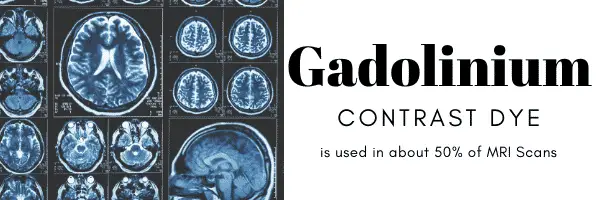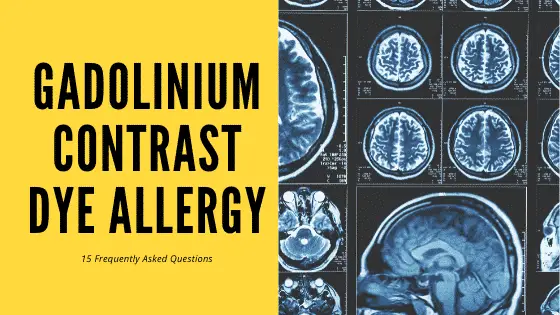17 FAQs on Gadolinium Contrast Dye
Gadolinium contrast dye is a very commonly used contrast agent for MRI studies.
Moreover, It has been in the media extensively over the past few years due to a spotlight on Gadolinium from Hollywood celebrities.
I have previously written about Gadolinium contrast reactions and side effects in this article.
I have also written about contrast dye in general in this article.

To continue on the theme of educating the public, I have written this article to address the Top 17 FAQs on Gadolinium contrast dye and hope you find it helpful.
So, If you have a question not listed, please leave your question in the comment section at the end of the article.
Top 15 Gadolinium FAQs
How much gadolinium use in an MRI?
- Gadolinium-based contrast dye for MRI is provided intravenously in around 0.2 mL/kg (0.1 mmol/ kg) at a quantity of 10 mL over 15 secs.
What are the signs of gadolinium poisoning?
- Pain
- Aching
- burning
- prickling
- deep bone discomfort
- hyperpigmentation.
- Muscle cells Problems.
- Shuddering
- Ocular Problems.
Is there an alternative to gadolinium?
- Researchers have established a manganese-based magnetic imaging contrast, a potential alternative to gadolinium-based agents, which bring substantial wellness for some people.
How dangerous is Gadolinium?
- GBCAs are generally safe for patients with good renal function. However, retention of Gadolinium has been have some effects consisting of possible Nephrogenic Systemic Fibrosis or NSF.
How much water should I drink after an MRI with contrast?
- Consume at least thirty-two (32) ounces of water over the following day. Moreover, If you are having problems drinking fluids, call your medical professional for directions to help clear this contrast from your body. If you are bust feeding, it is risk-free to continue after getting Gadolinium, according to the American College of Radiology.
Can you die from gadolinium contrast?
- There are no known cases of death caused by gadolinium injection for imaging procedures.
How Chuck Norris’s wife injured?
- According to Sunday’s variation of Sharyl Attkisson, Gena Norris nearly died from issues after having MRIs numerous years back. In the record, Gena Norris specified that gadolinium was injected to enhance the MRI images and that it lingered in her body for several years. Hence, It is interesting that the Norris family lost the court battle, and the contrast company was released from wrongdoing.
How do you test for gadolinium poisoning?
- Urine or blood tests utilize for the detection of gadolinium levels in the body. A biopsy of tissue can also be analyzed.
What does gadolinium show on MRI?
- One out of every three MRI scans uses Gadolinium contrast. It improves the quality of the images and makes them more diagnostic in terms of reviewing certain structures. For instance, it boosts the direct exposure of swelling, tumors, capillaries, and blood supply for some body organs.
Is Dotarem the same as gadolinium?
- DOTAREM is a gadolinium-based contrast agent used for intravenous usage with magnetic resonance imaging (MRI).
Is gadolinium necessary for brain MRI?
- For some exams, it is more beneficial to use contrast agents, just like in CT scanning. The contrast highlights certain structures and shows up better on the images acquired through scanning. Other exams, specifically a CT scan for kidney stones, must be done without contrast. Using contrast dye would cover up the stone, and you wouldn’t see it.
Does gadolinium toxicity go away?
- With time, signs and symptoms might vanish or drastically decrease, yet individuals reported on in our Research study of the Persistent Outcomes of Preserved Gadolinium from Contrast MRIs, have really been handling their persistent symptoms for as much as 5 years with no end noticeable.
Is there a cure for gadolinium poisoning?
- As you might anticipate, due to the fact that Gadolinium Poisoning is not an established, approved medical problem, there are no developed, accepted medical therapies. Moreover, The only thing we’ve heard of up to this point is chelation therapy.
Can gadolinium cause joint pain?
- Poisoning, nephrogenic systemic fibrosis (NSF) as well as gadolinium deposition condition (GDD) can happen months or years after undertaking an MRI scan. The most normal adverse effects of gadolinium-based contrast agents (GBCAs) are a sick stomach, headache in addition to lightheadedness, and a sense of malaise.
Can MRI done without gadolinium?
As discussed briefly in an earlier response, some MRI exams require contrast. Some exams require that you do NOT use contrast. Then other times it is added to enhance a series of exams. There is no point in doing an MRI that requires contrast for diagnostic images and refusing to use contrast during the study. This will yield suboptimal results and waste everyone’s time.

